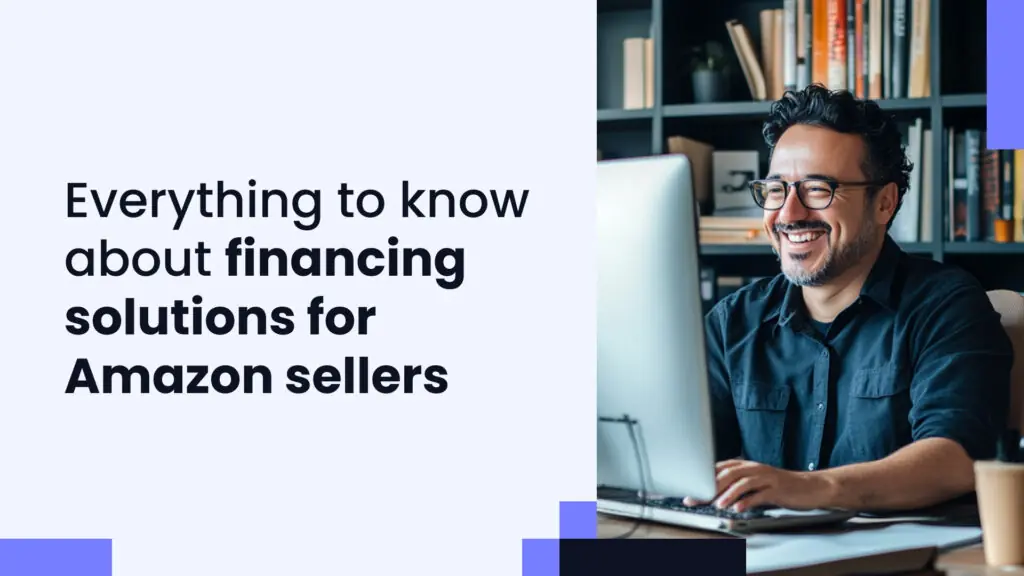When you are an eCommerce seller trying to reach as many customers as possible, Amazon is the place to be. It’s the largest online retailer in the United States, and the website where over half of US customers start their product search when looking to buy something. However, selling on Amazon is competitive, and it can be challenging to increase sales and grow your business without financing help.
Scaling your business requires funding, and financing for sellers should not have to be complicated. Some Amazon sellers have the option of securing funds through Amazon Lending, while others pursue other funding routes. There are many financing solutions out there to help Amazon sellers procure inventory, increase cash flow, improve advertising campaigns, create and analyze effective marketing strategies, and offer stronger customer service. Let’s take a look at different types of financing available to Amazon sellers.
What is Amazon Lending?
Amazon has a wide variety of resources open to sellers on the platform. One of these is Amazon Lending, an invite-only funding solution for Amazon sellers. If you are eligible, you’ll receive an invitation on Seller Central. Then, you apply for financing and, if approved, receive your funding directly from Amazon.
The general qualifications to receive an invitation to take advantage of Amazon’s lending programs include:
- 12 months of sales history
- $10,000+ in revenue over a 12 month period
- No legal conflicts with your business practices
- High customer satisfaction and no major customer complaints in the past 6 months
Financing options through Amazon Lending
Amazon Lending is Amazon’s approach to financing sellers on their platform. The special rates, offers, and capital are available only to Amazon sellers and exclusively offered to qualifying sellers through invitation only.
Since Amazon can already see your business performance, you can pre-qualify without a lengthy application process. In general, Amazon Lending claims that they take up to 5 days to process each application – which is completed through your Seller Central. You may have to provide some in-depth information that is not readily available through your Amazon account.
Amazon Lending and Amazon third-party services provide fast capital in a variety of formats to scale your seller’s profile and grow your business. However, the major downside of all of the Amazon Lending options is that they deduct your monthly payment directly from your seller’s account regardless of your eCommerce store’s performance. Amazon also uses your inventory as collateral so if you are unable to make the payment for any reason, Amazon will seize your inventory until your account is balanced.
There are several financing options available through Amazon Lending.
Subscribe to the eCommerce newsletter for
top industry insights
Amazon’s Buy with Prime through Amazon Lending
If there’s one thing that Amazon is famous for, it’s their Prime shipping option. Prime attracts customers because Prime membership gives customers free and fast shipping on hundreds of thousands of items.
Amazon recognized that engaging in Prime shipping has increased shipping costs for sellers on the platform. Therefore, in order to help improve cash flow and ease the strain caused by increased shipping costs, Amazon established Buy with Prime through Amazon Lending. Buy with Prime offers a 3-, 6-, 9-, or 12-month term loan with APRs as low as 8.99%. Like other Amazon Lending, this is an invite-only program for sellers who offer Prime shipping.
Term loans through Amazon Lending or Amazon approved third-party lender
Amazon and its affiliate third-party lender offer term loans to provide capital to sellers with proven track records of sales. These term loans are invitation only, like Buy with Prime, so you receive pre-qualification through your Seller Central. With approval, you can receive capital up to $750,000 based on your sales and revenue history.
Term loans have fixed monthly repayments, including interest, over a predetermined period of time. Interest rates start around 6-15% based on seller reports but some promotional rates may be lower. Term limits follow the same 3-, 6-, 9-, and 12-month time period. You can use this capital for growth and scaling or to finance day-to-day operations during busy seasons.
Interest-only loan through Amazon Lending or approved third-party lender
An interest only loan functions similar to term loans with one key twist – you pay only on interest for the first couple of months. Depending on your loan terms, you could pay several consecutive months of interest before your principal amount is added to your monthly payment.
Interest only payments are naturally lower than interest plus principal monthly payment. These are fixed rate amounts that allow you to use the capital at the beginning without a hefty payment on your mind. Lower payments over a fixed period of time gives you time to acquire and sell your inventory before the payments increase.
Might also interest you:
- Amazon prime day 2025: Strategy tips for sellers
- How to write Amazon titles and product descriptions that convert – with real examples
- How and why running out of stock hurts your Amazon ranking
Third-party Amazon affiliate lenders
Amazon Lending has a wide variety of options, but not every funding option is provided through Amazon’s lending department. The options discussed above had a lending option through Amazon Lending, with a second affiliate lender listed. The next two financing options are offered by Amazon Lending but only through their approved affiliate lending partners.
These options are also only available through invitation only, based on your sales and recorded revenue through the platform. You receive pre-qualification through Seller Central with capital amounts ranging from $1,000 – $750,000.
Line of credit (LOC) through third-party Amazon affiliate
A line of credit is a revolving credit stream that allows you to borrow a lump sum and draw what you need from the available credit. Once you make repayments, the principal balance becomes available to you again.
Lines of credit, or LOCs, function somewhere in the realm between term loans and credit cards. You make fixed repayments based on the principal amount that you borrowed, with interest, on a monthly basis until the amount is balanced. Interest rates and APR vary based on seller’s reporting, but it ranges from 6-15%.
A line of credit offers flexibility to borrow capital as you need it, allowing you to save money on interest rates. Amazon’s LOC offers lower interest rates than outside parties, and you can use the funds to scale your Amazon presence. You can continue borrowing money from the same LOC rather than apply for additional loans. By receiving your LOC through Amazon Lending, you bypass the credit checks, and Amazon guarantees your interest rate for LOCs is fixed, not variable.
While LOCs are versatile and revolving, they aren’t without their risks. Your fixed monthly payments change depending on the amount you pull from the LOC – meaning if you pull $1,000 in the first few weeks and an additional $3,000 later, your repayment amount increases to include the total principal amount borrowed ($4,000) plus interest. Changes in the minimum payment, including interest, can be difficult to budget.
Merchant cash advance (MCA) through third-party Amazon affiliate
The merchant cash advance is a highly utilized eCommerce financing option for both Amazon and independent online sellers. With MCAs there is no fixed monthly payment. Instead, you pay back the MCA as an agreed-upon percentage of daily credit and debit card sales.
Typically MCAs require that you generate at least 40% of your revenue through credit and debit card sales, but since Amazon only tracks your sales through their platform, you already meet that criteria.
The flexible payment structure is the main reason why eCommerce sellers choose to finance their businesses with MCAs. Only forfeiting a percentage of your revenue gives you an improved cash flow overall and less stress about meeting sales to cover the fixed payment amount. If you have a few months of low sales, you make lower payments, so your cash isn’t all tied up in your repayments.
However, since MCA repayments are not over a fixed period of time, and instead based on revenue, you cannot save money on interest by repaying the balance early. Since the MCA uses a capital fee tacked onto the principal amount, you owe that regardless. Additionally, the MCA option is more expensive overall than Amazon’s LOC or term loans
Third-party financing options for Amazon sellers
While Amazon likes to keep their sellers close and their lending closer, some Amazon sellers do not receive the invitation to utilize Amazon Lending. In addition, many eCommerce business owners prefer to choose another third-party financing solution that is a better fit for their business than Amazon Lending.
There are many financing options available to Amazon sellers outside of the Amazon platform. These funds are available both through traditional banks and through online lenders that specialize in eCommerce financing.
Term loans, lines of credit, and merchant cash advance
Popular content
- 14 strategies to improve your eCommerce business’s financial health
- 50+ ChatGPT prompts to elevate your eCommerce business
- A guide to pricing your product on Amazon
- 5 marketing metrics all eCommerce businesses should track
- All about Amazon PPC
All three of these financing solutions discussed above are also available through third-party funders. It’s important that we mention term loans, LOCs and MCAs here in addition to the other outside lending services so that you are aware they can be obtained independent of Amazon.
While Amazon’s rates and capital lending amounts are somewhat of a mystery, banks and other online eCommerce funding services may be more open about their qualifications. The application process is lengthier because you have to provide all of the information, whereas Amazon has your sales information on hand. Additionally, term loan and LOC rates are generally based on credit score and credit history, which could limit the amount of capital you receive.
On the flip side, MCAs have the potential to be incredibly expensive through online lenders. Based on what we know about Amazon’s competitive term loan rates, we can glean that their MCA capital rates are lower than outside lenders. Unfortunately, since rates are assessed based on an individual basis, we cannot confirm or deny that Amazon is more competitive in the cash advance lending market.
Credit cards
For fast access to capital, many eCommerce sellers turn to credit cards for a revolving line of credit. Credit cards give you a maximum lending amount to draw from and are used for point of sale purchases both in person and online. Many business credit cards offer a cash advance so you can borrow cold, hard cash against your credit card. However, in order to qualify for a credit card, you often need to undergo a credit check.
Credit cards are incredibly convenient, especially when it comes to emergency or last-minute purchases. They are also revolving lines of credit, allowing you repeat access to funds once you begin paying the principal balance. You only accrue interest on the principal amount borrowed, so you can spend as little or as much as you can afford to repay.
Like term loans and lines of credit, you can reduce the amount of interest accrued by paying more than the minimum amount each bill cycle. However, unlike term loans, you can avoid paying interest altogether if you pay off the balance before your first payment due date.
On the other hand, there’s a reason why we are told to avoid credit cards when we are younger. The interest rates and APR can be steep – ranging from 15-25%. If you don’t stay on top of your payments and reduce your balance, that interest will continue to compound each month causing you to pay multiple times the amount of your original credit.
Properly managed credit cards are a vital asset, but when abused or neglected, they can destroy your credit history, making it difficult to obtain other loans in the future.
Invoice factoring
ECommerce businesses and Amazon sellers that use invoices to obtain payment have a highly valuable piece of collateral they can sell for capital. Your invoices are a valuable commodity to an invoice factoring company. Since many invoices are not collected immediately, they are considered guaranteed future payment – but that future payment is not the same as having cash in hand or capital ready to use in order to fund your business.
Factoring companies will purchase your outstanding invoices for up to 99% of the total value and provide you with capital quickly. The factoring company will then collect on the invoices directly from your customers.
With invoice factoring you don’t have to struggle through credit checks or making repayments on a loan. Once you hand over your invoices to the factoring company and receive your capital, the transaction is complete. It’s easier to obtain than certain loans because it is more of a financial transaction – instead of inventory, you are selling your invoices.
You don’t have to worry about using your assets as collateral because the transaction is complete once the invoices are collected. On top of that, you don’t have to calculate interest rates or deal with fixed monthly payments.
It sounds like once you exchange invoices for capital your relationship with the factoring company is complete. But the reality is that if your customers or clients do not make their payment, you might be on the hook for the owed amount – plus fees. That’s why it’s essential to only sell invoices for known customers who have a solid track record of paying their bill on time. Vetting your customers prior to arranging an agreement like invoice factoring may take extra time, but will save you the headache of rectifying the situation later.
Revenue based financing
If the idea of making flexible repayments based on a percentage of your revenue sounded appealing to you while we talked about MCAs, then you should check out revenue based financing. A revenue based finance lender will provide capital up front so you can fund your operation. Then you make monthly payments based on your revenue until the loan is repaid.
Revenue based financing uses factor rates, which is your principal amount multiplied by a factor number (usually between 1.1 and 1.9) to calculate your total cost of the loan. Your repayments will cover this cost along with the principal value of the loan.
Like MCAs, revenue based financing’s flexibility allows for improved cash flow and fewer expense restraints. During periods of low revenue, you will make lower payments and are not responsible for rigid and fixed monthly payments like with term loans.
Unless otherwise indicated by your lender, you can use the capital to fund any part of your business – not just inventory. And finally, with factor rates, you know the total cost up front so you can compare your revenue forecasts to determine the length of time it will take to balance the loan.
While making lower payments during slow months is a nice perk, it also means you will make higher payments during more profitable months. One of the challenges of revenue based financing is that you cannot pay off your loan early to save money on interest. The factor rate guarantees the lender will receive the total cost, regardless of the time frame. Plus, revenue based financing is often more expensive than traditional loans.
Alternative funding for Amazon sellers
If you’re looking for an alternative funding option for your Amazon store, look no further than 8fig. Our growth platform gives you the tools and resources you need to plan, manage, and fund your Amazon business. From supply chain mapping to sales analytics, 8fig is here to help you reach your full potential. Plus, our funding is unlike any other funding source.
8fig funding is continuous and flexible. Instead of one lump sum payment, you get capital injections into your business when your supply chain needs it most, over and over again. In addition, you can make changes to your plan in real-time, whether that means requesting more funding to cover a damaged shipment of inventory or a change in your remittance schedule to reflect a slow sales period.
With 8fig, online sellers can cover up to 90% of their supply chain costs and grow their eCommerce businesses 2.5x as fast. Sign up for an 8fig Growth Plan today and find out how we can help you fund your growth goals.
Have article ideas, requests, or collaboration proposals? Reach out to us at editor@8fig.co – we’d love to hear from you.
- Personalization in eCommerce: How to drive conversions and retain customers
- 8 proven strategies to boost your Lunar New Year eCommerce sales (with actionable tips)
- 6 reasons content marketing beats PPC for eCommerce
- Expert tips: How to navigate Chinese New Year shipping delays
- 5 social media growth hacks eCommerce sellers need to know for 2025
Subscribe to the eCommerce newsletter for
top industry insights
to our blog
Read the latest
from 8fig

WhatsApp isn’t just for memes and group chats anymore. With a 98% open rate, it’s the secret weapon your eCommerce marketing strategy might be missing. Here’s how to do it right.

Stuck with extra inventory after Amazon’s Spring Sale? Learn five smart strategies to clear unsold stock, boost cash flow, and avoid future overstocks with smarter inventory planning.

Overhead costs quietly eat into your margins – unless you know how to outsmart them. These four strategies will help you cut the fat and grow leaner, faster.
